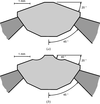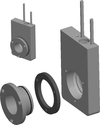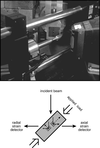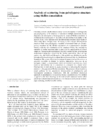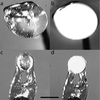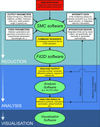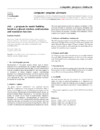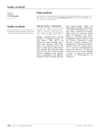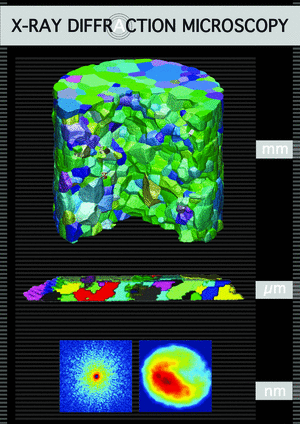issue contents
April 2006 issue

Cover illustration: Curvature mapping onto a surface drawn using the program Curvis. Courtesy of S. Piotto & R. Nesper [J. Appl. Cryst. (2005), 38, 223-227].
research papers
Small-angle X-ray scattering with an angular resolution of about two microradians is demonstrated in self-assembled colloidal crystals. Detailed information on the range of various order parameters can now be obtained even for colloidal crystals with spacings larger than a micrometre.
The pattern decomposition process has been improved by the inclusion of a Patterson method combined with error-correcting codes.
A novel description for angle calculations for a three-circle goniometer is presented.
The program LABELIT reliably establishes the point group of a data set by testing the point-group symmetry operators individually, rather than by evaluating average statistics over the entire data set.
Download citation


Download citation


The compressibility and the structural variations of ZnO single crystals up to 8.73 GPa were determined. The orientation relations between the low-pressure wurtzite-type and the high-pressure NaCl-type phase were analysed.
Glancing-incidence X-ray diffraction (GIXRD) is shown to be a powerful technique to obtain information about the thickness of films and coatings. In this work, X-ray reflectivity and GIXRD data are discussed together, and the consistency of the thicknesses evaluated for a crystalline layer by the two techniques is shown.
Nanotubes are formed after partial hydrolysis of the milk protein α-lactalbumin. This scattering study presents dimensions of the α-lactalbumin nanotubes and a model of their growth.
An automated program for molecular replacement has been written which searches for the fitting by rotating the weighted reciprocal lattice of the protein with respect to the calculated transform of the model structure, and uses fast Fourier transform translation functions for locating the molecules.
A commercially available heating/cooling chamber for X-ray diffraction measurements has been calibrated employing an X-ray diffraction-based method and a thermometry-based method. The two methods are compared, and the advantages and disadvantages are discussed.
Application of the GIFT method works well for evaluation of both neutron and light scattering data, but multiple scattering must be kept negligible. The advantage of light scattering is the fast data acquisition, while USANS covers a wider q range.
In situ resonant X-ray diffraction, in situ resonant small-angle X-ray scattering and in situ electron energy loss spectroscopy have been applied to the study of nanoscale and crystalline structure during activation of a Cu/ZnO catalyst for methanol synthesis.
Open  access
access
 access
accessA pressure vessel suitable for use at room temperature has been developed which allows neutron diffraction data to be collected from cylindrical samples of up to 10 mm diameter, at confining pressures of up to 160 MPa, whilst they are being mechanically deformed. This vessel is described, together with the results of commissioning experiments on the ENGIN-X beamline at the ISIS neutron facility, Rutherford Appleton Laboratory.
Download citation


Download citation


The technique of single-crystal growth of KLu(WO4)2 is briefly described and the morphology of the crystals grown is qualitatively studied. Some of its anisotropic properties (thermal expansion tensor, microhardness evaluation and refractive index tensor) have been determined.
Polydispersity and heterogeneity in structure and scattering is treated mathematically by utilization of multidimensional Mellin convolution. A general pathway for analysis is proposed.
Critical concentrations required for vitrification of aqueous solutions are determined for fourteen common cryoprotectants, for sample volumes ranging over four orders of magnitude and covering the range of interest in protein crystallography.
Spin-echo small-angle neutron scattering for magnetic samples is described. The experiment confirms the proposed theoretical description.
short communications
The possibility of generating hard X-ray surface modes of a periodic multilayer has been demonstrated analytically. Feasible experimental applications of these modes are suggested.
computer programs
Software for the automated analysis of scattering intensity profiles produced by synchrotron wide- and small-angle X-ray scattering experiments is described. It is capable of batch processing thousands of individual data files without user intervention.
A new software application to perform batch-wise data reduction is described.
MOTOFIT is a program for the least-squares co-refinement of multiple-contrast neutron/X-ray reflectometry data.
The program package ATSAS 2.1, allowing comprehensive analysis of small-angle X-ray and neutron scattering data, from primary processing to three-dimensional model building, is described.
computer program abstracts
HEL – a program for model building based on a phased rotation, conformation and translation function
HEL is a program for creating continuous chains of polypeptides or polynucleotides from positioned fragments. Structure fragments are located by the program NUT, which performs a phased rotation, conformation and translation function. The output of HEL is a PDB file.
books received
Free 



 journal menu
journal menu















